HP dm1z: Taking Fusion on the Road
by Dustin Sklavos on February 21, 2011 7:00 PM ESTBattery Life
The big news with Brazos, and by extension the HP dm1z, is the substantially improved battery life over Nile. While performance is nowhere near a strict win over that platform (Atom on the other hand...), power efficiency absolutely is. Take a look at this.
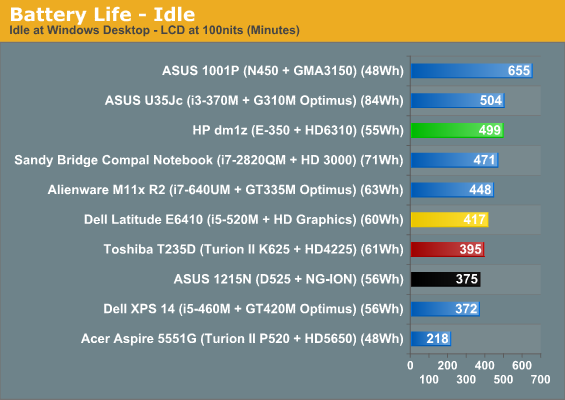
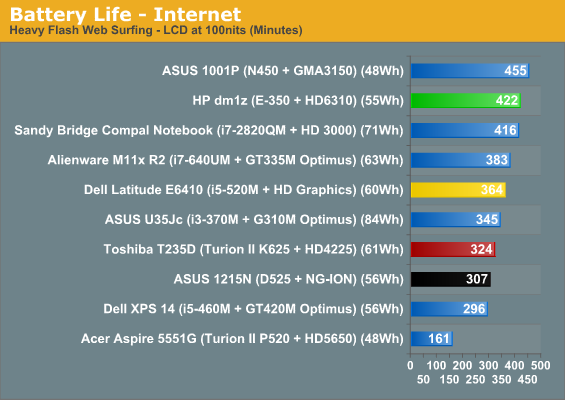
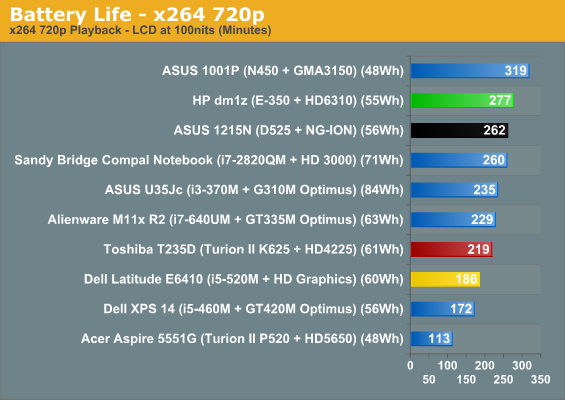
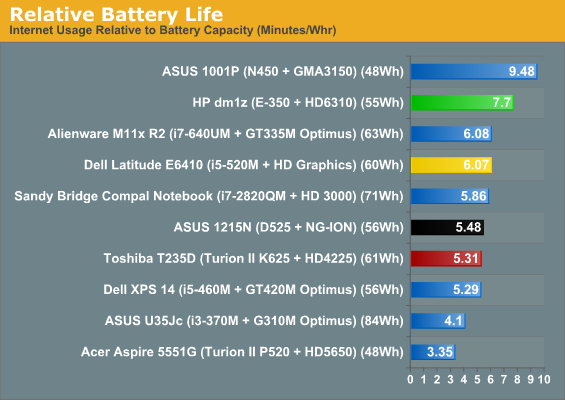
While portable gamers are probably still going to want to hang with Alienware's M11x, Brazos basically tells Intel's dual-core Atom to pound sand. The dm1z doesn't hit the battery life HP advertises (9.5 hours is pretty optimistic, probably only possible with wireless and Bluetooth disabled and the screen at the lowest brightness), but it still pulls more than seven hours of useful running time with a reasonable screen brightness and runs roughshod over Nile.
Heat and Noise
Unfortunately, where things get a little dicey (at least with the HP dm1z) is noise. First, the good news: heat output.

The internal components run at fairly reasonable temperatures, if a little on the high side, but fortunately those temperatures don't translate into an uncomfortable user experience. Quite the opposite in fact: the dm1z can happily be used on your lap without scalding you.

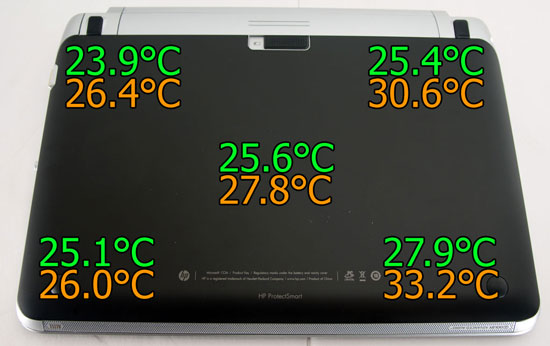
At idle the HP dm1z remains nice and frosty, and under sustained load the outside temperatures don't increase enough to make using the dm1z uncomfortable. But remember what I said about noise?
Part of the reason the dm1z is able to stay so comfortable is because the fan is almost constantly running. It's fairly low and not too obtrusive, but I have an AMD-based 15.6" Sony notebook on hand for review that runs quieter than the dm1z does at both idle and load. That may not be entirely fair because the 15.6" machine has more breathing room in the larger chassis, but it's nonetheless an issue. The fan in the dm1z doesn't spin up that much under heavy load, which would be more appreciated if HP was able to tune it to run just a little quieter at idle. This isn't make-or-break noise, but it's worth bringing up.
Update: Several of our readers pointed out that the HP dm1z has a utility called CoolSense as part of the HP Support Tools. It's supposed to allow some customization fan speeds to allow users to configure their laptop to prefer lower temperatures/higher noise, or lower noise/higher temperatures. As a matter of course we disable most of the manufacturer utilities to allow for optimal battery life results, so the above remarks reflect using the laptop without CoolSense enabled. Unfortunately, the dm1z has already been returned, so we are unable to run updated results. Anecdotally, noise is much better with CoolSense enabled.










108 Comments
View All Comments
JarredWalton - Tuesday, February 22, 2011 - link
Funny thing is that I even reviewed something like that:http://www.anandtech.com/show/2503/2
$2000 ($2600 with a 1st-gen SSD) and you were still saddled with Intel's GMA X3100. Look at the performance scores in 3DMark03-06 and PCMark05; heck, it even has Cinebench 10 results in there. So today you get roughly the same performance as the old Core 2 Duo U7500, with six times the graphics performance, and about twice the relative battery life, all for one-fifth the price. That's a pretty good advancement for only three years!
swaaye - Tuesday, February 22, 2011 - link
I think that in a 11.6" form factor you can do better. With this thing you're plunking down a good amount of money for some very basic performance. and GMA X3100 is not that much of an issue for most people. But if price is all that matters, sure this is a decent choice I suppose.I'd rather see Brazos used in a 9" netbook, myself. Really take advantage of its low power consumption and heat output.
Penti - Tuesday, February 22, 2011 - link
You can, but not for 449 USD. Rember Atom netbooks costs as much if not more when they come with W7HP and Crystal HD accelerator. Especially if you want a bigger battery then some anemic 3-cell. There's even no need to special order this (bto). If you go down to ridiculous small batteries, there's literally not much of a point of it. If you want something like a ULV or normal Core i5 in it you will have to pay 250 USD just for the CPU, add 40 USD for chipset. Add in TFT-panel, motherboard pcb and associated components, wireless, hdd, battery, keyboard, touchpad, memory and case(charger etc) and it's already at about 750 for the cheapest possible configuration. Probably 800 in real world. I.e another product. Built in support for basics (today) such as H.264 and H.264 flash video acceleration is key here. Not that you almost can game on it. It replaces the dualcore higher end atom netbooks and makes them obsolete. With this setup your high-def online videos works, no matter if it's flash or netflix Sliverlight. Not so much on netbooks with atom, even with the Crystal HD accelerator. Adobe has real problems with those kinds of platforms till they have moved over to a real video oriented workflow like they are trying to do with stage video api. It solves todays needs.Hell it's even fast enough to do high res software decoded H.264 with CoreAVC. It's pretty important because you can't always muck about and reencode files and reencoding files takes a long time.
This is about filling and meeting the needs of the low-end. AMD can keep TSMC busy with these I suppose.
swaaye - Tuesday, February 22, 2011 - link
I just dumped a HP 12.1" from 2009 which had a Turion Neo X2 1.6 GHz (faster than Brazos) with a discrete Radeon 3450. The Turion was not exactly snappy and the 3450 was pretty sad overall. It was passable yes, but not really impressive. I got it as a factory refurb for $450 but they retailed for around $800.silverblue - Wednesday, February 23, 2011 - link
There's a couple of differences. Brazos supports more instruction sets as well as a faster IMC (albeit single channel). The performance difference should be slight, if anything.swaaye - Wednesday, February 23, 2011 - link
According to another look at Brazos here on Anandtech, an Athlon 64 X2 at 1.5 GHz can be over 20% faster per clock in some applications. That's not slight. Sometimes they are similar, but then other times you see 20% slower which is quite ugly. A 1.5 GHz Athlon 64 X2 is already very slow.swaaye - Wednesday, February 23, 2011 - link
I shouldn't have said per clock. The comparison was an Athlon 64 X2 1.5 GHz vs. Brazos 1.6 GHz.fshaharyar - Tuesday, February 22, 2011 - link
The build up to the fusion was very good. But I'd like to say they late by 6 months to the party.If they had intrudoced this product to the market 6 months back it would have stolen the Intel thunder and their would have been a huge shakeup in the netbook market.
But still not taking anything away from their success we will see better alternatives in the mobile market with this teck piece.
AMD will have ensure that they refresh there current gen proc. every 8-9 months.
with regards to their GPU refresh as well as plan their CPU strategy.
Hal2011 - Tuesday, February 22, 2011 - link
NBS=No Glossy ClubWould love a new, little portable but waiting till manufacturers figure out that glossy screens are absolute crap. They are only there to hide the poor screen quality and to look good in the shop. Even on a cloudy day outside the local coffee shop, you still only look in a mirror. Hey, a mirror is more portable if I needed one! A small notebook is made to be used all over the place but these can't. Am I the only one?
cosmotic - Tuesday, February 22, 2011 - link
"The only thing that hurts about using the dm1z, really, is the amount of bloatware it ships with from HP.""The only major dents in the dm1z's armor are the poor screen and constantly running fan."
"The only fly in the ointment is that while the E-350 is a step up, it's a long overdue one and it's not quite the huge one we needed." … "but we don't need more cores in the E-350; we need faster ones."
Sound's more like three problems instead of one.